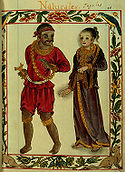
Lakan
Encyclopedia

History of the Philippines (pre-1521)
In Philippine history, the year 1521 marks the arrival of the first colonial power, and the beginning of what is often called the Spanish period. This period is thus described as the pre-colonial era or the pre-Spanish era....
Filipino nobility in the island of Luzon
Luzon
Luzon is the largest island in the Philippines. It is located in the northernmost region of the archipelago, and is also the name for one of the three primary island groups in the country centered on the Island of Luzon...
, which means "paramount ruler." It has been suggested that this rank is equivalent to that of Raja
Raja
Raja is an Indian term for a monarch, or princely ruler of the Kshatriya varna...
h, and that different ethnic groups either used one term or the other, or used the two words interchangeably. In Visayas and Mindanao, the most common term used to refer to this rank is "Datu
Datu
Datu is the title for tribal chiefs, sovereign princes, and monarchs in the Visayas and Mindanao Regions of the Philippines. Together with Lakan , Apo in Central and Northern Luzon, Sultan and Rajah, they are titles used for native royalty, and are still currently used in the Philippines...
". "Sultan
Sultan
Sultan is a title with several historical meanings. Originally, it was an Arabic language abstract noun meaning "strength", "authority", "rulership", and "dictatorship", derived from the masdar سلطة , meaning "authority" or "power". Later, it came to be used as the title of certain rulers who...
" was also used in the most developed and complex Islamized principalities of Mindanao
Mindanao
Mindanao is the second largest and easternmost island in the Philippines. It is also the name of one of the three island groups in the country, which consists of the island of Mindanao and smaller surrounding islands. The other two are Luzon and the Visayas. The island of Mindanao is called The...
.
Today, the term is still occasionally used to mean "nobleman", but has mostly been adapted to other uses. In Filipino Martial Arts
Filipino martial arts
Filipino Martial Arts refers to ancient and newer fighting methods devised in the Philippines, the most popular of which are known as Arnis/Eskrima/Kali. The intrinsic need for self-preservation was the genesis of these systems. Throughout the ages, invaders and evolving local conflict imposed new...
, Lakan denotes an equivalent to the black belt rank. Also, beauty contests in the Philippines have taken to referring to the winner as "Lakambini", the female equivalent of Lakan. In such cases, the contestant's assigned escort can be referred to as a Lakan. More often, a male pageant winner is named a Lakan.
Usage
The title Lakan can be spelled separately from a person's name (e.g. "Lakan Dula"), or can be incorporated into a singly spelled word (e.g. "Lakandula").Gat and Lakan. "Lakan" and "Gat" are often used interchangeably, since Gat (from the word "Pamagat", meaning "Title") refers to a person as a member of the nobility in general. Thus, someone like Lakandula is also named Gatdula.
Rajah and Lakan. It is sometimes argued that since the words Rajah and Lakan mean more or less the same thing, the two should not be used together. Thus, popular reference to Rajah Lakan Dula are said to be the result of mistaking Lakan Dula to be the full proper name of the historic king.
Prominent Lakans
Users of the title Lakan that figure in 16th and 17th century Spanish colonial accounts of Philippine History include:- LakandulaRajah LakandulaLakan Banaw Dula or Gat Banaw Dula , often referred to simply by his title Lakan Dula, and later baptised Lakan Carlos Dula, was the Lakan of the pre-colonial Philippine Kingdom of Tondo when the Spaniards first conquered the lands of the Pasig River delta in the 1570s...
, later renamed Don Carlos Lacandola, the king of TondoAncient TondoTondo, was a Philippine fortified kingdom which was located in the Manila Bay area, specifically north of the Pasig river, on Luzon island. It is one of the settlements mentioned by the Philippines' earliest historical record, the Laguna Copperplate Inscription...
, when the Spanish colonization of the Philippine Islands had begun. - Lakatagkan, the greatest ruler of the Kingdom of Namayan.
- Lambusan(Lakan Busan), a king in Mandaue in the Pre-Hispanic era.
- Lakan Usman,the king of bangsa Usman.
In popular culture
The name of Malacañang PalaceMalacañang Palace
The Malacañan Palace, commonly known simply as Malacañang, is the official residence and principal workplace of the President of the Philippines. Located at 1000 J. P. Laurel Street, San Miguel, Manila, the house was built in 1750 in Spanish Colonial style. It has been the residence of every...
, the official residence of the President of the Republic of the Philippines, is traditionally attributed to the phrase may lakan diyan, or "where the king [or head] resided".

